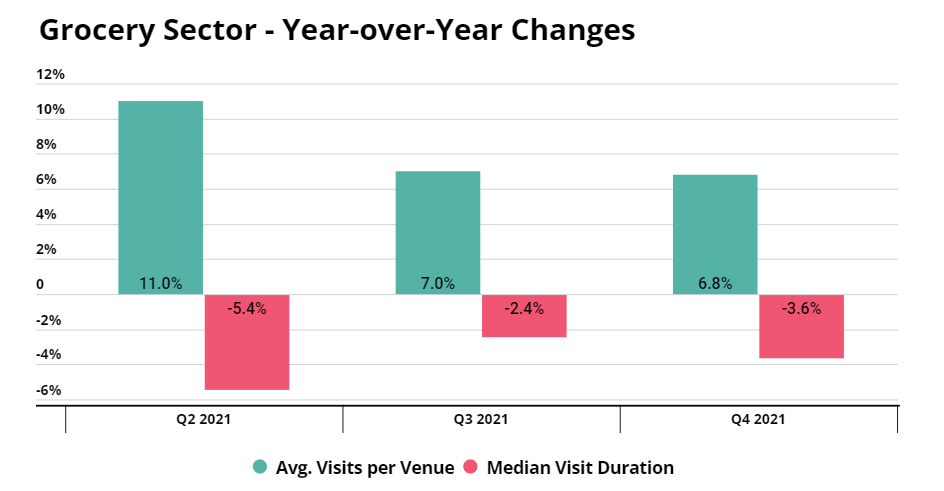
Our latest white paper examines recent changes in consumer behavior patterns. Over the past two years, the rise of omnichannel, shifts towards hybrid work, the growth of leisure activities, and increased economic uncertainty all contributed to rapid and unpredictable shifts in when, how, and where consumers shop.
These changes impact every facet of retail strategy, from chain-level considerations like when to open stores, shelf-level arrangements on where to place products, to product-specific decisions for pricing, packaging, and marketing goods.
Our report, “Unfolding Consumer Behavior Patterns in the New Normal,” provides an overview of some of these major shifts. Using foot traffic data, we identified six aspects of changing consumer behavior in six key retail categories. Below is a taste of our findings.
The End of Mission Driven Shopping
In the early days of the pandemic, grocery and superstores witnessed a phenomenon known as “mission-driven shopping.” Shoppers focused on accomplishing as much as possible in fewer visits made longer, less frequent trips to the store. Recently, however, mission-driven shopping has declined and foot traffic data from the past few quarters points to the emergence of the opposite trend: shoppers are making shorter, more frequent grocery and superstore runs when compared to 2019.
Shorter, More Frequent Visits
Grocery visit data for the last three quarters of 2021 shows that median visit durations decreased by 5.4%, 2.4%, and 3.6% in Q2, Q3, and Q4, respectively, compared to the same quarter in 2020. But while grocery visit duration is decreasing, each location is seeing more visits – the average number of visits per venue in Q2, Q3, and Q4 of 2021 was 11.0%, 7.0%, and 6.8% higher, respectively, when compared to the same quarters in 2020.
Yet, the growth in demand does not appear to be slowing. Beyond the continued visit strength, many grocery chains are seeing one of the major impacts of the pandemic was a greater shift to at-home cooking. In our latest survey, 57% of respondents noted that cooking was one of the adopted new behaviors and over 70% expected pandemic-driven hobbies to keep going.

Long-term Impact of COVID-induced behavioral changes
The shift therefore speaks to the long term impact of new behaviors and patterns that were driven by the unique pandemic environment. The continued uncertainty driven by inflation, increased gas prices and ongoing COVID concerns alongside this heightened propensity for at-home cooking could keep the grocery wave going far longer than originally expected. Isolating the areas where those changes have a longer term potential can help determine which retail segments could turn short term opportunity into long term growth.
Seeds of Change Pre-date the Pandemic
Diving into a specific superstore chain like Target shows that the increase in visits and decrease in visit length has happened gradually. Since 2019, there has been a slow but gradual decline in the length of Target visits, from 34 minutes median visit duration in Q1 2019 to 31 minutes in Q4 2021. At the same time, Target’s visit frequency has gradually increased, with the average number of quarterly visits per visitor rising from 2.8 in Q1 2019 to 3.3 in Q4 2021.
Relation with Online Shopping
Part of the shift towards shorter, more frequent visits may also have to do with the increase in online shopping. According to the survey we recently conducted, around 52% of respondents reported doing more online grocery shopping since the start of the pandemic. At the same time, 62% of respondents reported visiting the grocery store more often or about the same amount as they did before the pandemic.
This might mean that a significant share of shoppers now view their trips to the store as complementary to online shopping. Whereas before the pandemic, most consumers did their grocery shopping in store, many consumers now place their larger orders online and make quick, frequent trips to the store to grab items in between deliveries.
Impact on In-Store Behavior
The move towards shorter and more frequent visits does not just affect basket size. It can also impact the type of products consumers look to buy in stores, the aisles that customers pass – or don’t pass – during their visit, and retailers’ promotion strategies. Retailers and retail partners who understand the implications of this shift and learn to cater to visitors’ unique time-frequency balance will benefit.
To learn more about the data behind this article and what Placer has to offer, visit https://www.placer.ai/.







Sign up to receive our stories in your inbox.
Data is changing the speed of business. Investors, Corporations, and Governments are buying new, differentiated data to gain visibility make better decisions. Don't fall behind. Let us help.













Sign up to receive our stories in your inbox.
Data is changing the speed of business. Investors, Corporations, and Governments are buying new, differentiated data to gain visibility make better decisions. Don't fall behind. Let us help.





